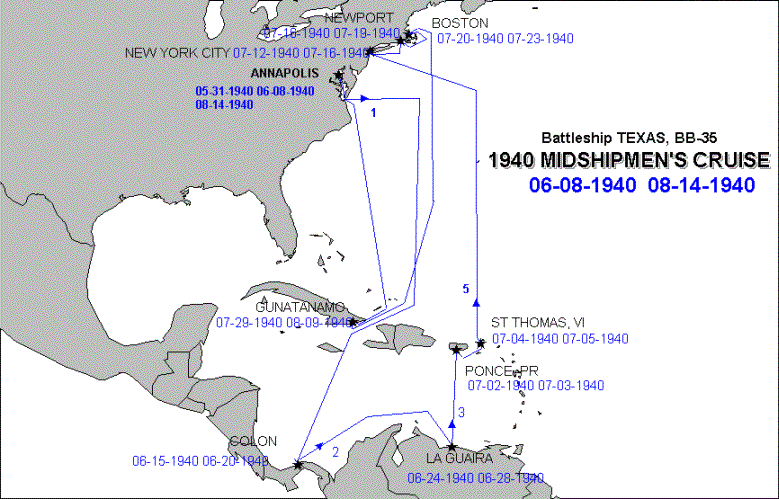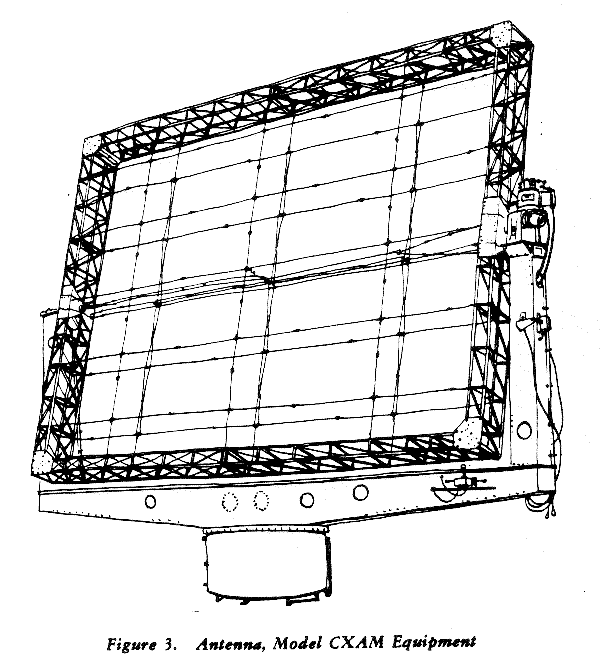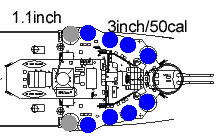
.
.
| East Coast: 1 September 1939 to 7 December1941 |
| The start of World War II in Europe, 1 Sept 1939, facilitated changes in operations. In November she carried out her first operations with the "Northern Patrol Group" into the North Atlantic. (These patrols were a couple of hundred miles vs the several thousand mile patrols in 1941). Though America was not at war, the TEXAS and the other US Navy ships conducted themselves on wartime footing, especially for submarines. In 1940 preparation for war continued. The level of battle drills increased
with additional drills in the Caribbean, from October through December. Such
drills in the Caribbean were usually during the 1st quarter of the year. |
 |
late 1939 to early 1941. Next to Turret 5 a "Woodie" Photo courtesy Morgan "Bugs" Smith, GSK during WWII
| 8 June to 14 Aug 1940 - US Naval Academy Midshipmen's Cruise (4th of 4) |
 |
| May thru July 1941 - Long Range North Atlantic Patrols | ||
| Between May and July 1941, TEXAS conducted 3 long-range patrols into the North Atlantic. On the three patrols, she was at sea six weeks and traveled about 15,000 nautical miles. The patrols were on a wartime footing. Zigzag courses were made for submarine protection. The crew wore combat gear. | ||
| The June map shows the attempt by Nazi submarine U-203 to torpedo BB35.
The maps were plotted using data from the Log Book and drawn with MapInfo, a computer mapping program. |
||
 |
||
 |
||
 |
||
|
After the July patrol, she went into dry dock, at
Norfolk Navy yard. In Norfolk. Here portholes on second deck were plated
over and the ship's first of four operational radar sets, CXAM-1, was installed.
Upon completion she relocated on 15 October to the US Navy base at Argentia,
Newfoundland, Canada for further Atlantic operations. She moved to Casco Bay, Me
on 28 November, which was her location when Japan attacked Pearl Harbor, 7
December 1941, and propelled America into World War |
 |
 |
As of 7 December 1941
Paint: Measure 12
Scheme was determined after some highly magnified examination
| External Changes | ||
| Airplane Types Aboard - 9 and 10 of 10 | ||
 |
#9 SOC-3 by Curtis |
16 October 1939 to 29 April 1941 The SOC-3 is aboard in a 2 Feb 1940 photo of TEXAS entering Havana. The identify of the SOC-3 left is #1 in Battleship Division 5. A scanned enlargement of the photo at the top | |||
 |
#10 OS2-U by Vought- Sikorsky |
1941 (prior to August) to not later than 12 December 1945, when
the catapult is removed. During the November 1942 invasion of North Africa, one airplane sank and another bombed enemy tanks. After the invasion, Walter Chronkite flew off TEXAS in an OS2-U when the ship was within range of Norfolk. At the start of 1943 three were still aboard but reduced to two before 1944. During the invasion of Normandy, the airplanes were removed. During the invasion of Okinawa, #8 sank during recovery due to damage from anti-aircraft fire and #7 strafed small Japanese boats. |
| FOREMAST |
Removed "Birdbath" platform during the Norfolk Navy Yard period of August - October 1941 for the installation of antenna for CXAM-1.
Installed Navigation Bridge - the catwalk around the forward side was installed between December 1940 to October 1941.
| RADAR - CXAM-1: 1st of 4 |
|
The ship's first of four operational radars CXAM-1 by RCA was installed during
the Norfolk Navy Yard period of August through October 1941. BB35 was one of 14
ships to receive the first available units. Radar antenna located atop the foremast, on the backside. Radar Control Room the transmitter, receiver and indicator were located in the former First Lieutenant’s Cabin on the port side of the Signal Bridge  |
 |
| ANCHOR - removal of spare portside |
The spare anchor, aft of forward port anchor, was removed in August - October 1941. An "Arrival Conference Report" prior to going into Norfolk Navy Yard lists the removal of the "dummy wildcat", which connects to the spare anchor via the anchor chain.
| Gun Changes: August - October 1941 |
| . | Total | Superstructure | 2nd Deck | Main Deck | Fore Mast | Main Mast | Sig Bridge | |
| 5inch | 14 | 2 to 0 | 8 | 6 | . | . | . | |
| 3inch | 10 | 8 | 2 | . | . | . | ||
| 50cal | 4 | . | 4 to 0 | 4 | . | |||
| 1.1inch | 16 | 8 | . | . | 8 |
| The first anti-aircraft additions since 1935 increasing the number of gun barrels from 16 to 30 of the WWII maximum of 94 |
| 1.1inch machine guns: 16 barrels - Signal Bridge and Superstructure |
Signal Bridge |
Superstructure |
3inch from 8 to 10 with two on
the main deck (maximum number but
not the final location) |
|
.
Started 11 May 1999 Chuck Moore, FTV (1st Texas Volunteers) BB35 volunteer group